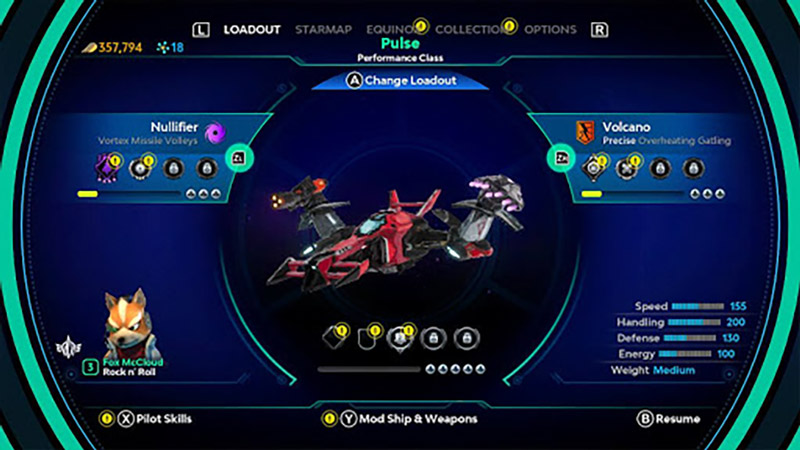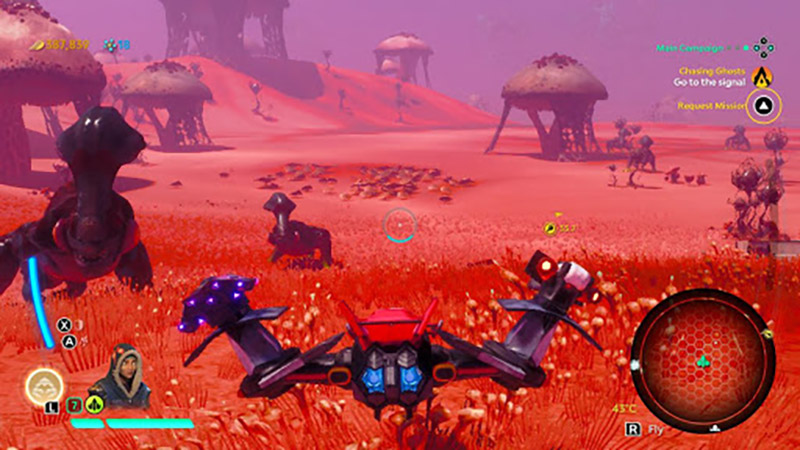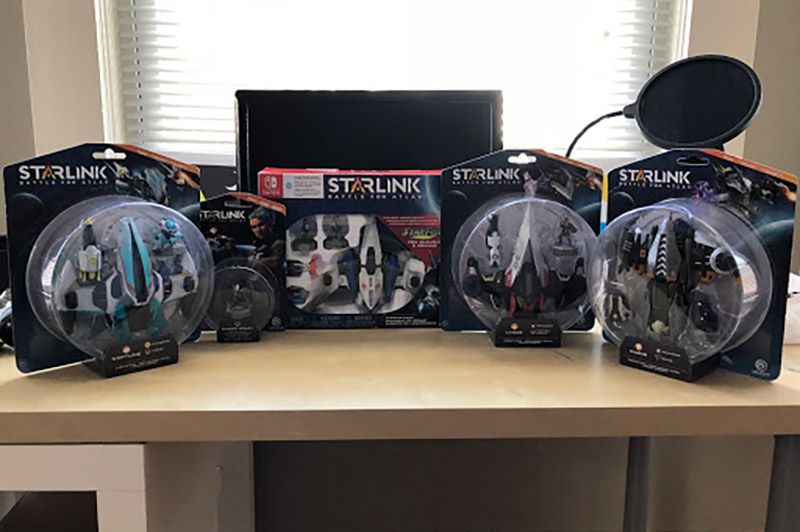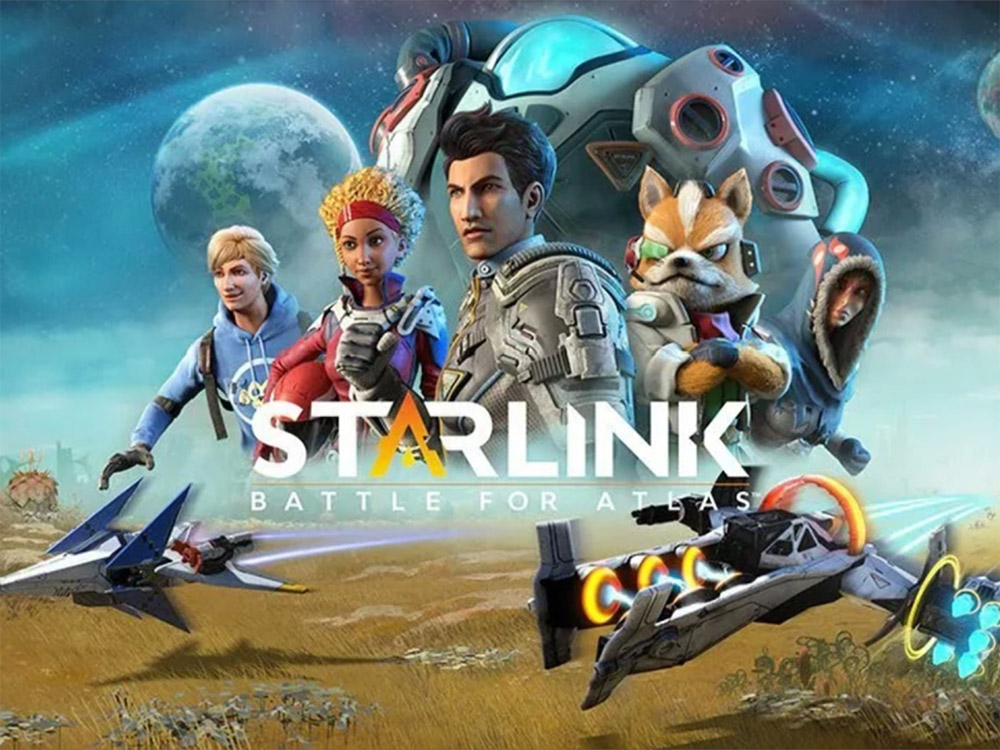For almost as long as video games themselves have existed, video game companies have been trying to find ways to augment their on-screen software with physical add-ons that contribute to the game experience. Some—Nintendo’s Virtual Boy and Power Glove both come to mind—are remembered more as punchlines than game-changing technology. But others—such as the Guitar Hero Guitar, the Xbox Kinect, or my personal favorite, the Donkey Konga Bongos (Dongos? Kongos?)—made their games into innovative, unforgettable multi-faceted experiences.
Starlink: Battle for Atlas, a new game from Ubisoft Toronto, the studio behind recent large scale platformers such as Assassin’s Creed: Unity or Far Cry 5, is a new entry into this pantheon. The game itself is a straightforward space-based RPG, but its most unique feature is its toys-to-life system with which a player can assemble their ship, weaponry, and even pilot from an assortment of purchasable toy sets, and then watch as their modified creation appears in the game in front of them. It’s an interesting concept, and the high quality of the toys makes them enjoyable to look at and customize. Unfortunately, however, the toy system never becomes the essential addition that Ubisoft hoped it would, and instead distracts from what could be—and is—an enjoyable experience in its own right.
Before I become too big a bummer, I do want to recognize that the core gameplay in Starlink ranges from thoroughly enjoyable all the way to downright breathtaking. The main story focuses around a group of pilots on the exploratory vessel Equinox, who are stranded deep in the Atlas system when their leader, Victor St. Grand, is taken hostage by a group known as the Forgotten Legion, who have taken an interest in his research, and its ability to harness energy they believe can be the key to their domination of the galaxy. You play as one of 10 pilots, each one with a specific set of abilities, as well as their own dialogue and personality, as you fly through the system, exploring planets, collecting energy and ship modifications, and fighting back against the legion in a bid to rescue your captain and save the galaxy while doing so.
Starlink is at its absolute best when it lets you feel fully in control of the starship you’ve chosen to control out of the fleet at your disposal. The game handles extremely well, as your ship darts through and soars over worlds that look impressive and crisp both in handheld and docked mode on the Switch, without any noticeable quality drop or framerate loss. There were space battles where my ship was barrel rolling while launching volleys of gravity rockets as it was tailed by a fleet of not-very-friendly outlaws, and I was able to watch in crisp and clear HD as my ship was repeatedly blown to bits—just like it would go in real life. The movement controls are fluid and intuitive, and the weapon-swapping system kept fights from feeling overly repetitive—one fight you might be using a gravity-based weapon and a volley of ice rockets to create a blizzard that enemies get sucked into, while the next you might use a flame battering ram to close the gap between you and a well-shielded enemy, before blowing them away with a close-range shotgun blast. Enemies have different weaknesses and resistances to elements and weapon types, so switching around everything that can be switched (and with changeable pilots, ships, weapons, wings, and stat-changing modulations, that’s a LOT) becomes not just a fun distraction, but a necessity for succeeding in the game.

I quickly found setups that I was most comfortable with (most of them shamefully involving the weapons with the most pronounced aim-assist, I’m lazy, I’m sorry), but would happily switch my loadout around whenever I was feeling bored or like things were getting a little stale. And the absolute best feature of the game is the one that feels the most special: the seamless travel transition from planet surface to space, and back again. It’s oftentimes the little experiences in a game that can be the most memorable, and the ability to rise off of a planet’s surface and soar into the sky, watching my ship heat up as it powered through the atmosphere and crested into space without any cutscene or loading break took my breath away the first time. As I continued to play, that exploratory moment of descending onto a new planet’s surface never got old. Which was fortunate, because a lot of other things did.
Starlink: Battle for Atlas does a great job introducing you to its world–the opening cutscenes and the first few missions all draw you deeply into the story, culminating in a major boss battle against a massive creature called a “Prime” that feels epic in both size and difficulty. But at that point, you’re only a couple hours into playing the game—maybe even less, if you don’t do much looking around—and a sinking feeling starts to set in that maybe, just maybe, you already get it. And very quickly, even though the game has a world the size of a literal galaxy, it starts to feel like the walls have closed in on you a bit.

Starlink does a little too much putting on hats and calling itself a whole new person. There are seven worlds, and all of them are gorgeous to explore, but explore them thoroughly and it starts to become clear that they’re different designs of the same core exploration experience. There are enemies with varying weaknesses and strengths that require you to vary your strategies, but fight enough waves and you start to realize that you’re fighting the same core four types of enemies over and over again. Even the dialogue, though snappy and well-acted, starts to grate a little after multiple go-arounds–the 15th time an outlaw crowed “Ha! Just dinged ya!” I wanted to reach through my screen, into their ship, and throttle them, shouting “REALLY? YA DINGED ME? I DIDN’T NOTICE! CONGRATS! Oh, by the way: if you’re an enemy, WHY CAN I HEAR YOUR COMMS IN MY SHIP??”
To Starlink’s credit, the world is vast from a collector’s standpoint: Gamers who love to complete 100 percent of a game’s missions and side quests will find themselves busy long after the main story is over. But for more casual, or younger gamers (the Ubisoft team says the game was originally made for the 8 to 12 age range), I fear that fatigue sets in fairly quickly. It must have been that fear of fatigue that led the developers to look outside the game for inspiration, which led to the two choices that, for better or for worse, set this game apart.
Starlink for the Nintendo Switch has two additional features apart from the main game that both deserve separate consideration from the game itself. The one that we haven’t talked about yet is the inclusion of a storyline featuring the characters from Star Fox, the popular Nintendo space pilot series that has left millions of parents over the years wondering why their child won’t stop shouting “Do a barrel roll!” at them. I will admit, at first I was skeptical of the shoe-hornedness of the crossover; the Star Fox team is introduced when the Starlink pilots literally run into them in space, for God’s sake. But I happily eat my words: The game’s flight system and combat style is a perfect fit for Fox McCloud and his crew, and their mini storyline is well handled, and a welcome addition to the main story’s action. Plus, being able to fly the Arwing around at 30 FPS is truly a joy.
The second additional feature is the one we’ve already touched on: the physical toys that can accompany the game. I will admit that there is satisfaction found in assembling a ship on your table and snapping it into place on your controller mount, just to watch that ship come to life in front of you on the screen. The toys come in three components: pilots, ships, and weapon attachments, and along with a dock for your controller, all snap easily into place. But overall, the physical component seems to be far more trouble than it’s worth. Pausing the game to find the component you want to swap out was always more tedious than simply accessing it from the game’s menu digitally. What’s more, the whole concept seems to fly directly in the face of one of the main appeals of the Switch: its portability. My Switch comes with me on train commutes, and I grab for quick seshes during breaks at work: I find it hard to imagine adding four detachable spaceships and a host of weapon parts and pilot figurines to my backpack. And, perhaps most damningly of all, the physical version makes for an actively worse game experience. If you buy the physical starter pack for the Switch, you start the game with two ships, two pilots, and three weapons. Buy the digital edition (for $15 less,) and you start with five ships, seven pilots, and twelve weapons. As each additional physical pack costs around $25, you’d be running up to $150 plus just to get where the digital edition starts off. While the toys are indeed cool—and I will readily admit to understanding their appeal as a collector’s item—they should be considered heavily optional when it comes to playing the game: certainly not a required feature.

Starlink: Battle for Atlas is a good game trying a little too hard to be a great game. It’s a person with a pleasant personality and an easy disposition getting a spray tan because they worry people won’t like them the way they are. It’s no virtual boy or power glove—the game is too successful and the tech too well done for that dubious distinction. But it does give unfortunate raise to the cynic in me: the expansive world with little to do… why? The expensive additions that don’t add much at all… why? In the end, I put down Starlink entertained, but wanting for more. But I also wouldn’t be surprised if I go back just to fly my Arwing through space. That moment as you burst through the atmosphere and see the whole universe stretching out around you… that’s something special.

